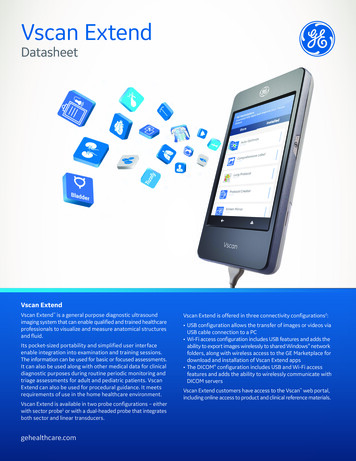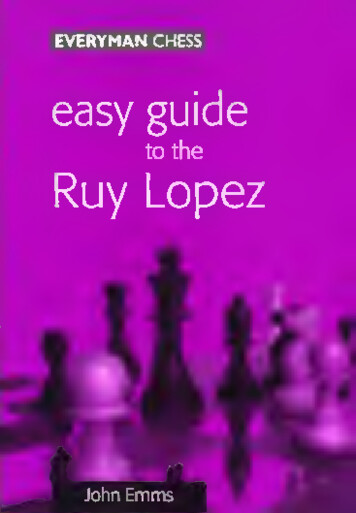
Transcription
Ruy Lopez
easy guideto theRuy Lopezby John EmmsEVERYMAN CHESSEveryman Chess, formerly Cadogan Chess, is published by Everyman Publishers, London
First published in 1999 by Everyman Publishers pic, formerly Cadogan Books pic,Gloucester Mansions, 140A Shaftesbury Avenue, London WC2H 8HD inassociation with Gambit Publications Ltd, 69 Masbro Road, London W14 OLS.Copyright 1999 Gambit PublicationsThe right of John Emms to be identified as the author of this work has beenasserted in accordance with the Copyrights, Designs and Patents Act 1988.All rights reserved. No part of this publication may be reproduced, stored in aretrieval system or transmitted in any form or by any means, electronic,electrostatic, magnetic tape, mechanical, photocopying, recording or otherwise,without prior permission in writing from the publishers.British Library Cataloguing in Publication DataA CIP catalogue record for this book is available from the British Library.ISBN 1 85744 220 2Distributed in North America by The Globe Pequot Press, 6 Business Park Road,P.O. Box 833, Old Saybrook, Connecticut 06475-0833.Telephone 1-800 243 0495 (toll free)All other sales enquiries should be directed to Everyman Chess,Gloucester Mansions, 140A Shaftesbury Avenue, London WC2H 8HDtel: 0171 539 7600 fax: 0171 379 4060To ChristineEveryman Chess Series (formerly Cadogan Chess)Chief Advisor: Garry KasparovSeries Editor: Murray ChandlerEdited by Graham Burgess and typeset by Petra Nunn forGambit Publications Ltd.Printed in Great Britain by Redwood Books, Trowbridge, Wilts.
ContentsSymbolsBibliographyIntroduction1Rare Third Moves for Black2The Schliemann Variation3The Classical Variation4The Berlin Defence5The Deferred Steinitz and Other Fourth MoveAlternatives6Moller and Arkhangelsk Variations7The Open Lopez8The 8 a4 Anti-Marshall9Ideas in the Closed Lopez10Rare Closed Lopez Variations11The Karpov Variation12The Zaitsev Variation13The Smyslov Variation14The Breyer Variation15The Chigorin DefenceIndex of Variations456918293547556981899699107119122127142
Symbols V2-V20-1(n)(D)checkdouble checkcheckmatecapturebrilliant movegood moveinteresting movedubious movebad moveblunderchampionshipteam championshipworld championshipcandidates eventinterzonal eventzonal eventolympiadEuropean Clubs Cupjunior eventwomen’s eventmemorial eventrapidplay gamecorrespondence gamequalifying eventthe game ends in a win for Whitethe game ends in a drawthe game ends in a win for Blacknth match gamesee next diagram
BibliographyBooksNunn’s Chess Openings, John Nunn, Graham Burgess, John Emms and JoeGallagher (Everyman/Gambit, 1999)Encyclopaedia of Chess Openings, Volume C (Sahovski Informator, 1997)The Complete Spanish, Alexei Suetin (Batsford, 1991)Mastering the Spanish, Daniel King and Pietro Ponzetto (Batsford, 1993)The Closed Spanish: Zaitsev and Karpov Lines, Anatoly Bykhovsky (Batsford,1993)Ruy Lopez Breyer System, Les Blackstock (Batsford, 1976)Spanish without .a6, Mikhail Yudovich (Batsford, 1986)Winning with the Schliemann, Mikhail Tseitlin (Maxwell Macmillan, 1991)The Open Spanish, Mikhail Krasenkov (Cadogan, 1995)The Marshall Attack, John Nunn and Tim Harding (Batsford, 1989)PeriodicalsInformatorChessBase MagazineThe Week In ChessBritish Chess MagazineChess Monthly
Introduction1 e4 e5 2 )f3 ic6 3 &b5 (D)The Ruy Lopez (or Spanish Game,as it’s often called) is a simple open ing, with a simple idea. White’s secondand third moves have both increasedthe pressure on the centre, and in par ticular the e5-square. Give or take afew developing moves, the next stageof White’s plan is to take control of thecentre and increase the pressure on e5with the advance d4, which is oftensupported by c3. It may be a simpleenough plan, but it can be highly ef fective. Because of this, the RuyLopez has stood the test of time. Otheropenings come and go, drifting in andout of fashion, but the Lopez has al ways been a popular choice for all lev els of player, from novice to WorldChampion, and it will continue to be.Mobile and Little CentresIf Black buckles under the pressureand relinquishes the centre with.exd4, then depending on whetherWhite has played c3 or not. White ei ther obtains a Mobile Centre or a LittleCentre, either of which is generally fa vourable to the one in possession.This is the Mobile Centre. The pairof central pawns on e4 and d4 controlmany important squares and give Whitea space advantage plus more freedomof movement for his pieces. In addi tion, White has the option of creating acentral breakthrough with a timely e5.This thrust could provide a platformfor a successful attack on the blackking.The diagram overleaf shows theLittle Centre. This pawn structure is
Introductionless dangerous for Black than the pre vious one, but it still favours White.The pawn on e4 is more advanced thanBlack’s central d6-pawn, which onceagain means that White has morespace to move his pieces. Added tothis is that White also has control overthe important d5- and f5-squares.How Does Black React?Of course Black has many differentpossible defences against the Lopez,but in general there are two differenttypes of strategy. The first is to meetWhite’s d4 advance by bolstering thee5-pawn with pawns and pieces. Thisplan is seen in all the closed defences(Chapters 9-15), the Classical Varia tion (Chapter 3), the Deferred Steinitz(Chapter 5) and the trendy Mpller andArkhangelsk Variations (Chapter 6).Black’s second strategy revolvesaround a swift counterattack againstWhite’s e4-pawn. This is seen in linessuch as the sharp Schliemann Varia tion (Chapter 2), the Berlin Defence(Chapter 4) and the Open Lopez(Chapter 7).7A Real OpeningAs a junior player I was quite contentto play openings such as the ViennaGame, the King’s Gambit and theScotch Gambit, obtaining quick victo ries against the unsuspecting oppo nents who did not know their theory.However, as time progressed andmy opponents became more experi enced, my repertoire of tricky open ings just didn’t seem work any more.No one was falling for my traps, andoften all I was left with was a sterileequality, or something even worse.In 1989 I appeared in the BritishChampionship for the fourth time.Keen to make more of an impressionthan on my previous undistinguishedattempts, I vowed that as White Iwould give up my ‘baby openings’,take a deep breath and try the RuyLopez. After all, it was time I grew up!My chance came in round 9, when Iwas paired with Scotland’s top playerPaul Motwani, who was a seasonedl.e5 player. The experience was quiteenlightening.Emms - MotwaniBritish Ch (Plymouth) 19891 e4 e5 2 )f3 ic6 3 &b5 a6 4 a4&f6 5 0-0 &e7 6 Eel b5 7 &b3 0-0 8c3 d6 9 h3 &e610 d4 &xb311 xb3In Chapter 10 I advocate 11 axb3,but in 19891 was only just learning thetheory. Still 11 xb3 is not bad either.I was already struck by the fact that Ihad a perfectly good position, andeven more importantly, one that waseasy to play. This was just the sort of
Easy Guide to the Ruy Lopezthing I needed when confronting some body rated 200 points higher than my self.Il.d5 12 exd5 ia5 13 c2 exd414 ixd4 lxd5 15 id2 &f616 2f3c5 17 H5 Sa718 l.d2 c4 19 SadiSd7 20 &cl le7 (D)21 lg5!As far as I could see, I hadn’tplayed any special moves, only natu ral ones, yet my position was gettingbetter and better. This was certainly agood choice of opening.21. lg6 22 le4 Se8 23 ixf6 gxf6 24 ,&h6 lxb2Actually, I had missed this tactic,but such is the dire position of theblack king. White is winning in anycase. So Lopez players are even lucky!25 Sxe8 xe8 26 Sxd7 #'xd7 27#’e4! #dl 28 &h2 #d8 29 Wc6 &d330 xa6 b4 31 cxb4 cxb4 32 &gl ldf4 33 Wb7 ld5 34 g3 &b6 (D)35 &e3 id5 36 &h6 &g7 37 xf7 &h8 38 J .d4 k5 39 &xe5fxe5 40 #'e6 &g7 41 &15 &f8 42 ld6 1-0It goes without saying that after thislittle episode, I was converted, and Ihaven’t strayed off the path since.How This Book is WrittenThroughout the book I have attemptedto give a concise theoretical overviewof the main lines of the Ruy Lopez,with a repertoire slant for the whitepieces. In spite of this, I have tried toremain as objective as possible in mycoverage, although as I mentioned inmy earlier Easy Guide to the NimzoIndian, this can be quite difficult for ahardened advocate of one side!
1 Rare Third Moves forBlack1 e4 e5 2 f3 k6 3 &b5(D)Black has a significant number ofunusual third move alternatives whenfaced with the Lopez. After 1 e4 e5 2 )f3 3c6 3 ,&b5 we shall look at (inroughly ascending order of impor tance) the following moves:A: 3.i.b49B: 3.d610C: 3. id412D: 3.g614E: 3. ige716First of all, we should look at someblack moves that are considered evenrarer than rare, and are a mixture of thebad and the ugly!a) 3.Sfe7 4 0-0 )d8!? is an in triguing scheme of development, whichis not easily refuted. Black plans .c6and .d6, while the knight may re enter the game via e6. That said.White has many ways to achieve anedge. After 5 d4 c61 like 6 iLd3 d6 7b3!?, with ideas of icb2 or ,&a3.b) 3.#16 tries to make it difficultfor White to achieve the d4 advance.However, the queen can become ex posed on f6. One way to keep a plus iswith 4 )c3 )ge7 5 d3 a6 6 ,&c4.c) 3.f6 was, unbelievably, playedby Steinitz. Almost anything will doagainst this. 4 0-0 )ge7 5 d4 )g6 6 )c3 is one way to secure an ample ad vantage.d) 3. .a5! ? is a bizarre move, whichdoes have the point that 4 d3?! )a7! 5,&c4 b5 wins a piece, although 6,&xf7 &xf7 7 )xe5 is still very un clear. White should probably just play4 0-0, when 4. ia7 5 &e2 d6 6 d4leaves the knight looking rather sillyon a7.A)3.&b4This is another odd-looking movethat was once a favourite of the Swed ish grandmaster Jonny Hector. Thebest one could say about 3. JLb4 isthat it’s not quite as bad as it looks!4 c3
10Easy Guide to the Ruy LopezWhy not gain time on the bishopwith this natural Lopez move?4.JLa5 5 sa3! (D)A good move. This knight will ar rive at c4, gaining more time by at tacking the bishop.5.JLb6 6 &c4 d6Or 6. \f6 7 d3 d6 8 a4 a6 (8.0-0?9 JLxc6 bxc6 10 a5 JLc5 11 b4 wins apiece) 9 lxb6 cxb6 10 JLc4, when thebishop-pair gave White an advantagein Barlov-Velimirovic, Yugoslav Ch1994.7 0-0 lge7This knight belongs on e7 in thissystem. 7. lf6 8 d4 exd4 9 cxd4 0-010 &g5 h6 11 JLh4 &g4 12 .xc6bxc6 13 e5 dxe5 14 ftcxe5 gave Whitea clear plus in Schiissler-Lukez, Helsingborg 1990.8 a4 0-0At this point there’s a pitfall, ofwhich White must be very wary. Onfirst inspection the move 9 a5? seemsto trap the black bishop, but Black hasthe neat trick 9. lxa5! 10 lxa5JLxa5 11 Exa5 c6! and it’s Black whowins material. No better is 9 ,&xc6?! lxc6 10 a5, because Black can play10.Ae6!.9d3 &e69.d5 opens the position prema turely. In Hellers-Hector, Haninge 1990White got a big advantage after 10exd5 xd5 11 Eel g4 12 h3 Axf313 xf3 xf3 14 gxf3 f6 15 a5 &c516 b4! &xb4 17 &xc6 &xc3 18 &xb7Eab8 19 a6 Bfd8 20 Ae3.10 xb6 axb6 11 g5 &c8 12 f4!(D)Hellers-Hector, Stockholm RiltonCup 1990/1. White’s two bishops andextra space give him a clear edge.B)Steinitz’s Defence. This has a repu tation of being quite solid, but ratherpassive, and it’s not very popular thesedays. If Black wants to play lines in volving an early .d6, it’s more nor mal to use the deferred move-order of3.a6 4 JLa4 and only then 4.d6 (seeChapter 5).
Rare Third Moves for Black4d4White has other moves, but this isthe most direct way to achieve a goodposition.4.JLd7Not the only move. Others include:a) 4.exd4 5 xd4 &d7 (5.fce76 &g5 a6 7 -&xc6 ixc6 8 d2 c79 ic3 &xg5 10 &xg5 0-0 11 0-0-0gave White the usual spatial plus inUlybin-Adams, Khalkidhiki 1992) 6JLxc6 &xc6 7 &c3 (7 &g5 &e7 8Wxg7 JLf6 9 xh8 &xh8 10 xd8JLxb2 is not so clear) 7. lf6 8 JLg5JLe7 9 0-0-0 0-0 10 Shel Se8 11 &blwith a slight advantage for White,Anderssen-Paulsen, Vienna 1873.b) 4. JLg4 (Marshall’s idea) 5 dxe5dxe5 6 xd8 (6 Wd5 Wxd5 7 exd5JLxf3 8 gxf3 a6 9 dxc6 axb5 10 cxb7Hb8 11 a4! b4 12 a5 Sxb7 13 a6 Eb814 JLe3 was also better for White inCanfell-Wohl, Australian Ch 1991)6.Exd8 7 JLxc6 bxc6 and now not8 sxe5? allowing 8.Edl#, but 8l5)bd2, which maintains an advantagefor White. One possible continuationwould be 8. d6 9 ic4! &f6 (9.f610 JLe3 and 9. JLxf3 10 gxf311JLe3 a6 12 0-0-0 are also slightlybetter for White) 10 JLe3 lxe4 11 )cxe5 JLxf3 12 3x13, reaching a po sition which shows us why this line isnot played by Black: everything else isequal, but Black’s pawn weaknesseson the queenside are permanent.5 0-0This is the main line, but White canalso consider ambitious ideas involv ing queenside castling after 5 lc3.Both 5. lf6 6 JLxc6 JLxc6 7 d311exd4 8 ixd4 JLd7 9 JLg5 JLe7 100-0-0 and 5.exd4 6 lxd4 g6 7 JLe3JLg7 8 d2 if6 9 &xc6 bxc6 10 &h60-011 JLxg7 4?xg7 12 0-0-0 Ee8 13 f3are better for White.5. .6f6Once again the main move, al though 5.exd4 6 lxd4 g6!? is a moreambitious way of developing. After 7 sc3 JLg7 8 j xc6 bxc6 the sequence9 Eel se7 10 JLf4 is the most annoy ing for Black. If then 10.0-0 Whitepresses forward with 11 e5!, for exam ple 11.d5 12 la4 with a strong bindon the dark squares. Black can preventthe advance with 10.f6, but the sim ple plan of exchanging dark-squaredbishops with 11 Wd2 0-012 i.h6 b813 JLxg7 &xg7 14 b3 was enough togive White an edge in J.TodorovicYanovsky, Belgrade 1988.6 lc3 exd4After 6. JLe7 White can virtuallyforce Black to give up the centre in anycase by 7 Jtxc6 JLxc6 8 d3!. Now8.&d7 9 JLe3 exd4 10 ixd4 0-0 11f4 looks good for White, so Black nor mally plays 8.exd4. Following 9 S)xd4 JLd7 White can develop aggres sively with 10 b3 0-011 JLb2 Ee8 12 f4it.f8 13 Eael. Hamdouchi-Campora,Dos Hermanas 1998 continued 13.c514 lf3 JLc6 15 ld5 JLxd5 16 exd5 h617 c4, when Black was struggling tofind breathing room.7 &xd4 JLe7 8 Eel 0-08. .6xd4 9 Wxd4 xb5 10 ixb50-0 11 JLf4 &d7 12 Eadl a6 13 &c3 .f6 14 b4 left Black without anyprospects in Hracek-Smejkal, CzechCht 1997/8.
12Easy Guide to the Ruy Lopez9 JLxc6 bxc6If Black captures with 9.jk.xc6,then White should just proceed with10 b3 and 11 &b2.10 d3!More accurate than the immediate10 b3, which allows Black to break outwith 10.d5! Ile5 .b4!.10.Se8 11 b3 f8 12 &b2 g6In the game Nunn-Portisch, Buda pest Ct playoff (6) 1987, Black di verged with 12.c5, but after 13 lf3JLc6 14 Sadi h6 15 e5! White wasstill better.13 Sadi Lgl 14 h3 b8 15 f3(D)pm'i ii.umleave the Lopez bishop hitting thin airon b5. Bird’s Defence has never reallycaught on, however, probably becauseBlack moves his knight twice in theopening, just to see it exchanged.4 ixd4 exd4 5 0-0 (D)Eiii.il* mm&ifiB B&iinmmi &0At this point Black has two seriousoptions:Cl: 5.c612C2: 5.JLc513After 5.4 e7 White should con tinue with 6 d3 c6 7 ,&a4 d5 8 ld2,e.g. 8.dxe4 9 sxe4 sf5 10 - b311 Wh5, with some advantage, Petrosian-Siier, Varna OL 1962.White prepares the e5 advance. InNunn-Portisch, Budapest Ct playoff(2) 1987, White kept the advantage af ter 15. e6 16 e5 &d5 17 &e4 M518 c4.C)3.&d4This defence was invented in thenineteenth century by the Englishmaster Henry Bird. The idea is toCl)5.c6Immediately putting the question tothe white bishop. This line is less pop ular than 5. JLc5.6 JLc4 d5Another way for Black to play is6. lf6 7 Hel d6 8 c3 ig4 9 h3 ie510 d3 ixc4 11 dxc4 dxc3 12 lxc3-&e7 13 JLf4 0-014 Wd3, when Black’s
Rare Third Moves for Blackweak pawn on d6 gave White an edgein Matanovic-Gliksman, Yugoslav Ch1967.7 exd5 cxd5 8 Sel ie7The more natural 8.it.c7 allows 9 &b5 , when 9.JLd7 runs into 10 g4! so Black is forced to play theugly 9.&f8.9 &fl M610 c3 d7 11 a3 ic612 a4 .e7 13 Z&c2M 6Forced, as 13.0-0 14 S)xd4 lxd415 Wxd7 &xd7 16 Sxe7 c2 17 EblJLf5 18 d3 is clearly better for White.14 JLb5 dxc3 15 dxc3 0-0 16 ,&e3Hfc8 17 Sadi (D)This position arose in Geller-Klaman, Moscow 1949. The pressureagainst Black’s isolated d-pawn givesWhite a very pleasant game.C2)5.JLc5This is the main line of Bird’s De fence. Black develops a piece andwaits for White to commit himself be fore attacking the bishop.6 d3 c6 7 JLa413In this line the bishop is betterplaced on a4, out of the way of any.d5 breaks from Black.7. . ie7More recently. Black has been ex perimenting with 7.d6, giving theknight the option of going to f6. Thisidea works after 8 f4 f5!? 9 l M2 )f6!10 e5 dxe5 11 fxe5 S)g4, when Blackhas succeeded in reaching a playableposition. However, White should playmore craftily with 8 it.b3!, planning tomeet 8. tf6 with the pinning 9 JLg5!.If Black reverts to 8. ,.4}e7, then Whitealso reverts to the original plan with 9f4!, leading to lines similar to the maintext.8f4!This powerful move has done agreat deal of damage to the reputationof Bird’s Defence.8. .f5This move is virtually forced. Fail ure to prevent White’s f5 thrust can re sult in a grim position, e.g. 8.d5 9 f5f6 (9.0-0 10 f6! is even worse) 10«h5 *f8 11 *hl SLA7 12 c3 &e8 13 h4 dxe4 14 dxe4 Wb6 15 b3 Ml16 S)d2 dxc3 17 bxc3 and Black is inbig trouble, Kindermann-Tatai, Buda pest 1987.9 JLb3 d5 10 exd5 fcx d5 11 Eel 4 f81 l.'i f7 is no better. White contin ues 12 fcd2 Se8 (NCO gives 12.g613 tf3 &g7 14 &xd5 Wxd5 15 Se5 d6 16 b4! JLxb4 17 JLb2 with a clearadvantage, as 17.c5 18 a3 Jia5 failsto 19 Exc5!) 13 h5 *f8 14 Exe8 xe8 15 Wxe8 4?xe8 16 Md5 cxd517 tf3 M7 18 b3 Ec8 19 &b2 &b6
14Easy Guide to the Ruy Lopez20 Scl and the d4-pawn is ripe forpicking.12 WhSl (D)Black’s airy king position is a majorcause for concern. Kamsky-Ivanchuk,Tilburg 1990 continued 12.g6 13 h6 4?g8 14 ld2 Af8 15 fh3 g716 if3 h6 17 e5 Sff6 18 &xd5 cxd5 19 b3! &h7 20 .b2 b6 21 Wf3Se8 22 T2 Axe5 23 Sxe5 Sxe5 24&xd4 Se2 25 &xb6 Exf2 26 Axf2and White had achieved a winningendgame.D)3.g6This quiet positional move has beenfavoured by former World ChampionsSpassky and Smyslov. White can nowplay 4 c3, when Black’s best reactionwould be to transpose to Chapter 5with 4.a6 5 JLa4 d6 6 d4 JLd7. At tempts to do without .a6 give Whitemore options, for example 4.d6 5 d4M7 6 Wb3! &a5 7 Wa4 c6 8 &e2 b59 c2 gl 10 0-0 ie7 11 dxe5 dxe512 a4, leading to an edge for White,Dolmatov-Kholmov, Sochi 1988. How ever, as well as 4 c3 White can play ina more direct fashion with.4 d4!? exd44. .4kd4 5 sxd4 exd4 6 xd4 fS7 e5 is very favourable for White, e.g.1. Mb6 8 #xb6 axb6 9 c3 &b4 10 d2 Ha5 11 a4 c6 12 se4! -&xd2 13 &xd2 sh6 14 b4 Ea8 15 2d6 &e716 .d3 with an overwhelming posi tion, Kasparov-Garcia Santos, Galiciasimul 1991.5 &g5 e7Of course, Black cannot continue5. . ge7, due to 6 icf6. The alterna tive to 5.iLe7 is 5.f6, when Whitekeeps the advantage after 6 JLh4 JLg77 0-0 thgel 8 &c4 a5 9 Sfxd4 iec610 Wd5 xc4 11 xc4 d6 12 k3&g4 13 id4 ixd4 (not 13.fce5? 14 b5 !) 14 xd4. Now Nunn-Davies,Hastings 1987/8 continued 14.0-0?!15 f4 mi 16 h3 &e6 17 f5! gxf5 18exf5 JLxf5 19 ld5 and White’s attackwas much too strong. 14.g5 is a moreresolute defence, when 15 JLxg5? failsto 15.c5 16*fa4 Ad7 17 ?2b5 b6.However, White can keep a small pluswith 15 i.g3 h5 16 h3 JLe6 17 f4.6 Axe7 (D)Now Black has two options:Dl: 6.Mxel14D2: 6.&gxe7 15Dl)6. Mxel 7 xc6 dxc6The greedy 7.Wb4 is punishedby 8c3 xb2 9 xd4 xal 10 0-0 f611 e5! dxc6 12 exf6, when White’s at tack comes crashing through.8 xd4 f6 9 k3 &g4
Rare Third Moves for BlackIn Sax-Smyslov, New York 1987,White built up a menacing kingside at tack after 9.0-0 10 0-0-0 JLe6 11 h3Efd8 12 c3 b5 13 e5 i.d7 14 14JLe8 15 g4 a5 16 g5 lh5 17 3g4 b418 la4. In particular, Black suffersbecause his queenside pawns are lessmobile, a perennial problem of thedoubled pawn complex.10 0-0-0 &xf3 11 gxf3 0-0 12 e3&h5 13 f4 b6 14 f5 (D)Luther-Dautov, Bad Lauterberg1991. White’s initiative on the kingside gives him the advantage.15D2)6. gxe7 7 xd4 d5Delaying this for a move with7.0-0 8 lc3 d5 doesn’t change theassessment of the position. White cankeep an advantage after both 9 JLxc6bxc6 10 b3! dxe4 11 lxe4 and thesimple 9 ixc6 bxc6 10 JLd3 Eb8 11b3.8 ic3 dxe4 9 JLxc6 ixc6 10 lxc6 xdl 11 Sxdl bxc612 ixe4M5 13 0-0! 0-0After 13. .xe4 14 Efel f5 15 f3Ed8 16 fxe4 f4 17 Exd8 4 xd8 18&f2 &e7 19 Edl g5 20 4?f3 h5 21Ed4 Eb8 22 b3 Black’s queensideweaknesses proved fatal in WahlsZsu.Polgar, Dortmund 1990.14 Ed4 &g7 15 f3 Efe8 16 EfdlEab8 17 b3 (D)Black’s weak a- and c-pawns makethis endgame rather uncomfortable forhim. Nunn-Salov, Skelleftea WorldCup 1989 continued 17.Eb5 18 Sc4Ed5 19 Ed3 Ee6 20 *f2 h6 21 Ea4it.xc4 22 Exe4 &f6 and now 23 &e3would have kept a clear advantage.
16Easy Guide to the Ruy LopezE)3. . ge7This move was briefly popular inthe late 1980s, when it was used bygrandmasters such as Ivan Sokolovand Alexei Dreev. Black’s idea is tofollow up with .g6, .it.g7 and a later.d5. Here we look at two alternativesfor White:El: 4&c3!? 16E2: 4 c316El)4 lc3!?A tricky move, against which Blackmust defend very carefully.4. .g6If 4.4tlg6 White should open theposition with 5 d4 exd4 6 lxd4. Fol lowing 6. JLc5 7 JLe3 JLxd4 8 JLxd40-0 9 &e3 d6 10 0-0 &h8 11 #d2 f512 f4 fxe4 13 sxe4 We7 14 ig3White was better in Barczay-Sydor,Lublin 1969.5 d4 exd4 6 id5! &g7 7 i.g5 h6Forced, as 8 JLxc6 was threatened.8 JLf6 - .xf6 9 xf6 4?f8 (D)W10 sxd4Perhaps White should consider theuntried 10 d2!? here. The point is tomeet 10. 7 with 11 ixd4!, trans posing to the next note. 10. lf5 11 sd5 sg7 12 tf4 ie6 13 sxe6 dxe6 14 0-0-0 favours White, as does10.d5 11 &xc6 sxc6 12 ixd5. Thisleaves us with 10.d6, but here 11&xd4 lf5 12 ixc6 #xf6 13 exf5bxc6 14 JLxc6 may give White anedge. This line needs a practical test.10. . f5!Murey-Dreev, Moscow 1989 con tinued 10. 7, which White met bythe shocking 11 d2!. Dreev contin ued weakly with ll. sg8 12 Sid54if6 13 ic3 ih5 14 g4, when Whitehad an overwhelming position. How ever, grabbing the knight with 11.&xf6also gives White an irresistible attackafter 12 *fc3, e.g. 12.fce5 13 f4 d614 fxe5 dxe5 15 0-0-0!, or 12. ixd413 xd4 e6 14 JLc4 d5 15 exd5 &d7 16 0-0-0 a6 17 d6!.11 sh7 l?Black is fine after 11 exf5 xf6 12.&xc6 dxc6 13 fxg6 g7!, preparing.Sd8.11. .5.h7 12 exf5 1T6 13 &xc6dxc6 14 0-0 c5Emms-Twyble, London 1998. NowWhite should play 15 sb5!? Axf5 16 xc7 Hd8 17 1T3 xb2 ip SabiWxc2 19 Sxb7 with good compensa tion for the pawn.E2)4c3g64. .a6 5 JLa4 d6 6 d4 .&d7 trans poses to Chapter 5.
Rare Third Moves for Black5 0-0 JLg7 6 d4 exd4Black gives up the centre, but plansto strike back immediately. 6.0-0 7d5 a6 8 JLe2 ia7 9 c4 is obviouslybetter for White.7 cxd4 d5 8 exd5 ixd5 I'D)9&g5In my opinion this is more accuratethan 9 Eel &c6 10 JLxc6 bxc6 11JLg5, which may transpose, but un necessarily gives Black the added op tion of 1 l.Wb8!?.9. d610 Eel Ae611 bd2 0-012 ie4 b4 13 Axc6 bxc6 14 cl!Efe8 15 Ad2 b61715. . 16 se5 Af5 17 sc5(NCO) also gives White an edge.16 sc5 JLf5 17 &e5 Ead8Giving up the dark squares with17.JLxe5? is not to be recommended.After 18 dxe5 sb4 19 .g5 sc2 204M7! JLxd7 21 xc2 Black has chronicweaknesses around his king.18 a3 f6 19 Wc4 Ef819. .6e6? fails to 20 xe6 Exe6 21 xf7!.20 b4 (D)Donchev-Radulov, Bulgaria 1991.1prefer White’s active knights to Black’sbishop-pair.
2 The Schliemann Variation1 e4 e5 2 &f3 Sk6 3 &b5 f5 (D) v \A A A .- A 1. B&HagA»sg ifaThe Schliemann Variation is proba bly the sharpest way of meeting theRuy Lopez. Black immediately goeson the counterattack in the centre, inKing’s Gambit fashion. Most posi tional considerations are overtaken bytactics and hard variations, so there’smuch more homework for the studenthere than in many of the other chap ters. That said, a well-prepared playeron the white side could certainly lookforward to facing the Schliemann. Af ter all, this line is fun for White too,but only if you know your stuff!The Schliemann is quite popular atclub level, where many white playersrefuse to take up the challenge and optout with the passive 4 d3. However,this is just the type of move Schlie mann players would enjoy playingagainst, as Black is put under no im mediate pressure and has been able to‘get away with’ his third move. After,for instance, 4.fxe4 5 dxe4 4 tf6,Black already has a comfortable de velopment plan and White no longerhas a d-pawn! Instead of this, Whitemust try to punish Black for his sinsand thus I’m recommending the criti cal reply 4 c3!.The Theory of theSchliemann1 e4 e5 2 &f3 sc6 3 &b5 f5 4 sc3!(D)Utl 1WiAWiW f;; f w ,§ ilAt 8 AjBfjtilA:B:C:Black has three main options:4. sf6194. sd4194.fxe421
The Schliemann Variation19A)4On first impression this looks themost natural follow-up, but in fact it’snot very popular due to the strength ofWhite’s reply.5 exf5!Whereas 4 exf5?! e4! would haveembarrassed the knight, now 5.e4can be effectively met by 6 h4!. Af ter 6.d5 7 d3 .&e7 8 dxe4 dxe4 9#xd8 Axd8 10 g5 0-0 11 0-0-0White is simply a pawn to the good. If5. . Skl4 White should simply snatchanother pawn with 6 lxe5, when6. .c6 7 i.d3 d5 8 0-0 d6 9 tf3 &xf510 &xf5 Axf5 11 Sel JLe7 12 We2was clearly better for White in Chandler-Hermann, Bundesliga 1995/6,while 6.&c5 7 0-0 0-0 transposes tothe main line of this section.S.Ac5 6 0-0 0-0 7 xe5 sd4Black’s only chance to complicate,as 7.4ixe5 8 d4 is clearly in White’sfavour.8 JLd3 d5 9 tf3 c6White is also a safe pawn up after9. . sxf5 10 AxfS Axf5 11 d4 &d6 12 ie5.10 h3! (D)Stronger than 10 b3?! &xf5 11&xf5 Axf5 12 d4 Ab4, when Blackhas some compensation for the pawn.After 10 h3!, Ulybin-O.Rodriguez,Benasque 1992 continued 10. sd7?!11 sxd4 &xd4 12 ie2 &b6 13 c3&e5 14 c2 d4 15 cxd4 xd4 16 xd4 xd4 17 d3 Axf5 18 Jis3 h419 f4! and White held a clear advan tage. The straightforward 10.4ixf5 isstronger, although after 11 JLxf5 JLxf512 d4 d6 13 e5 &e4 14 &c2 Blackdoesn’t have enough compensation.B)4. sd4!? (D)A deceptively tricky move, whichwas first suggested by Alekhine.Black seems to break all the openingrules by following up 3.f5 with mov ing his one developed piece again, but4. sd4 is not as bad as it first looks,and should be treated with consider able care.5 JLc4!
20Easy Guide to the Ruy LopezOf course White has other playablemoves, including 5 exf5 and 5 Aa4,but this one asks Black the most ques tions; for example: where will he cas tle?5.c6Other moves for Black include:a) 5.d66d3 )f6(6.Ae77 Axg8Exg8 8 ixd4 exd4 9 h5 &f8 10 kI5 looks good for White) 7 lxd4!exd4 8 e2 fxe4 9 dxe4 ixe4 (9.c510 0-0 xe4 11 &f4 is clearly betterfor White) 10 xd411 Ag5 andWhite’s lead in development hadreached nearly decisive proportions inAbramovic-Kovacevic, Yugoslav Ch1985.b) 5. tf6 6 d3 (6 0-0 xf3 ! 7 xf3 fxe4 8 \xe4 c6 is less clear)6. xf3 7 xf3 f4 8 g3 g5 9 gxf4gxf4 10 Axf4! exf4 11 e5 Ab4 120-0-0 Axe 3 13bxc3 e7 14 exf6 xf615 Bdel 'i’dS 16 Be4 and White wasclearly better in Tosic-Sahovic, Vrnjacka Banja 1982.6 0-0 d6Black can also offer to sacrifice ma terial with 6. 6. Emms-Tebb, Brit ish Ch (Norwich) 1994 continued 7d3!? 5)xf3 8 xf3 f4 9 Axf4!? exf410 e5 d5 11 exf6 xf6 12 Efel &d813 lxd5 cxd5 14 Axd5 Eb8 15 d4 witha very unclear position. Instead of 7d3. White should grab the material onoffer with 7 xe5 fxe4 8 7 c7 9 lxh8. After 9.d5 10 Ae2 Ad 6 11 h3Af5 12 d3 it’s difficult to believeBlack has enough compensation.7 exf5!Sensibly opening the position up.Instead 7 Eel xf3 8 xf3 f4 9 d4 f6 gives Black the type of positionhe wants, where the f4-pawn crampsthe white pieces.7.Axf5Once more Black has some otheroptions:a) 7.d5 8 xe5 6 9 Eel Ae710 Ad3 0-0 11 the2 thxf5 12 Axf5Axf5 13 d4 leads to a typically advan tageous position for White, who is apawn up and can boast an outpost forthe knight on e5.b) 7. lxf5 8 d4 and now 8.exd49 Bel Ae7 10 lxd4 is clearly betterfor White, while 8.d5 runs into 9 lxe5! dxc4 10 h5 g6 11 lxg6 f6 12 c2 tLe7 13 ixh8.c) 7. xf3 8 xf3 f6 9 d4exd4 10 Bel &d8 11 e4 xf5 12 g3 gives White a clear plus, accord ing to NCO.8 )xd4 exd4 9 Eel &d7Black has problems defending hisd4-pawn after 9.Ae7 10 thel.10 the! f6 11 g3 (D)We have been following TimmanDanov, Wijk aan Zee 1971, which
The Schliemann Variationcontinued ll.Se8 12 Exe8 &xe8 13 e2 &d7 14 c3 dxc3 15 dxc3, whenWhite had a big lead in development.C)4.fxe4Black’s main continuation. The epawn is eliminated and Black preparesto occupy the centre, for one move atleast!5 lxe4Now we deal with Black’s two mainchoices:Cl: 5. )f6C2: 5.d52122Cl)5. f6 (D)This line was unpopular for a longtime, as White can virtually win apawn by force by 6 ixf6 xf6 7 e2. However, ways were then dis covered of drumming up counterplayfor Black.6 &xf6 When improvements for Black werebeing discovered in this line. White21started to try 6 e2!?, but my impres sion is that Black’s resources are suffi cient in this line after 6.d5 7 xf6 gxf6 8 d4 Ag7 9 dxe5 0-0! 10 Axc6bxc6 11 e6 Be8 12 0-0c5.6. M\f66. .gxf6? is a mistake. After 7 d4 e7 (or 7.e4 8 g5!) 8 0-0 e4 9 d5! d8 10 Eel Agl 11 h4 White had acrushing position in Emms-Sylvan,Copenhagen 1992.7 e2 Ae7 8 Axc6 dxc68. . xc6 9 xe5 leaves Blackstruggling to castle, but 8.bxc6 isquite interesting. White should con tinue with 9 lxe5, when 9.c5 10 0-0 b7 11 b3 0-0-0 12 Ab2 was betterfor White in J.Diaz-Antunes, SantaClara 1991, while 9.0-0 10 0-0 d611 d4 c5 12 Ae3 Axe5 13 Wc4 Ef714 dxe5 Wfxe5 15 Wxc5 also leavesWhite a clear pawn up.9 xe5 f5With this move Black keeps his op tions open regarding which side tocastle. The other main line runs 9.0-010 0-0 Ad6 11 d4 Af5 (ll.c5 12Ae3 b6 13 f4 cxd4 14 xd4 b7 15Wg4 Eae8 16 Badl gave White theadvantage in Kuporosov-Yandemirov,USSR 1986) 12 c3!? (12 f4 Axe5 13dxe5 Wg6 14 Ef2 Bad8 leads to theposition after Black’s 15th move inMarjanovic-Yilmaz, discussed in thenext note) and now:a) 12.
Ruy Lopez Breyer System, Les Blackstock (Batsford, 1976) . A Real Opening As ajunior player I was quite content to play openings such as the Vienna Game, the King's Gambit and the Scotch Gambit, obtaining quick victo ries against the unsuspecting oppo
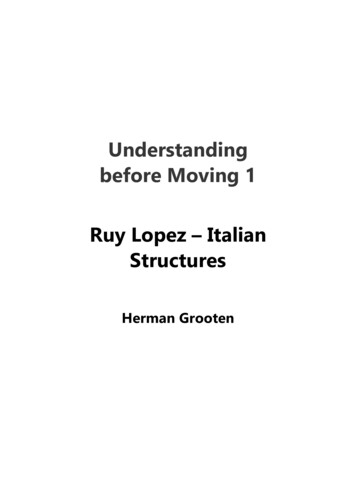



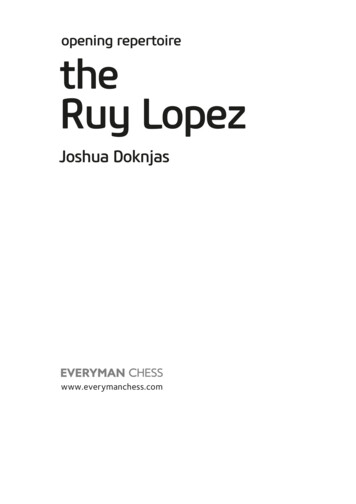
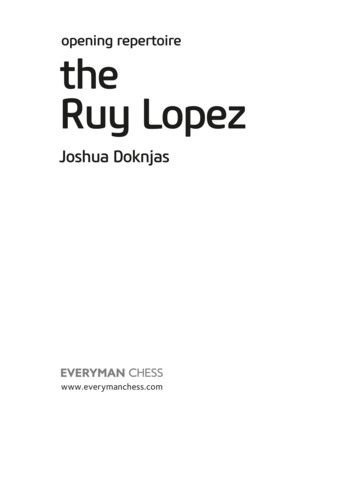
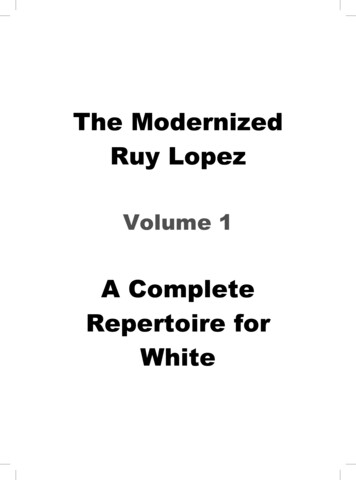
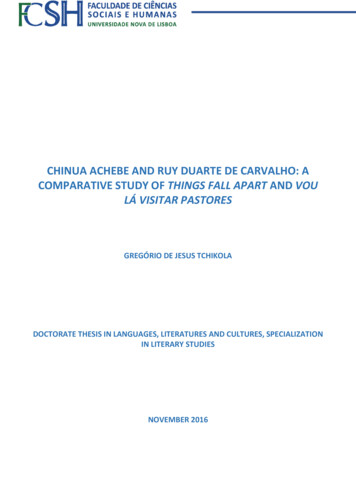
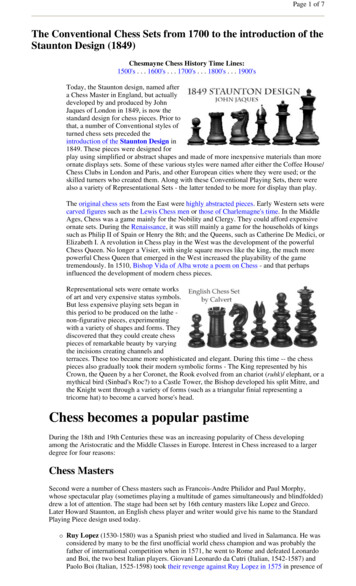
![March 3rd, 2017 [Manage Archive in Microsoft Outlook 2016]](/img/34/archive-outlook-2016.jpg)
